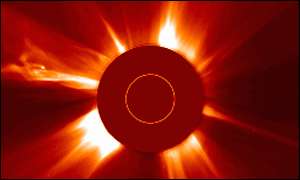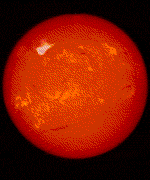Monday, 7 February, 2000, 12:22 GMT
Major flare erupts on Sun
 The massive eruption spurts out (at 9 o'clock on Sun's face)
The massive eruption spurts out (at 9 o'clock on Sun's face) |
A major solar flare erupted on the north-east limb of the Sun on Saturday. It was one of the largest and brightest optical flares seen in recent years, according to data from the US National Oceanic and Atmospheric Administration and the Space Environment Centre.
It was followed by the ejection of billions of tonnes of super-hot gas. This was not directed at Earth but the increasing activity raises the possibility that a future eruption could damage satellites and communications and power supplies on Earth.
 The flare was extremely bright
The flare was extremely bright |
Eventually the flux-tubes become distorted to the point of breakdown. When this happens a vast amount of energy is explosively liberated in a solar flare.
B for brilliant
The flare spewed out radiation right across the electromagnetic spectrum. For optical light intensity, it got the maximum rating of "B" (for brilliant).
And in terms of high-energy X-rays, the flare was in the most powerful "X"-class. The Goes 8 satellite detected the bright surge which emitted ten million times more energy than a volcanic explosion.
However, solar physicists point out that this size of blast represents less than one-tenth of the total energy emitted by the Sun every second.
Solar flares become more common during a sunspot maximum. The current sunspot cycle is predicted to peak in mid-2000, and remain high for at least a year.
Complex magnetic field
Although the 5 February solar flare was big and bright, it did not come from a particularly impressive sunspot group. Active region 8858, the site of the flare, covers just 200 millionths of the solar disk.
However, its magnetic field is complex, exhibiting strong gradients that make it a likely site for flare activity. Space weather forecasters expect the region to continue developing in the coming days. If that happens, we could be in for more major flares.
 The ejection began shortly after the flare
The ejection began shortly after the flare |
Earth safe
The ejected material does not appear to be headed for Earth and therefore represents no threat to our communication systems. However, if the active region produces further ejections in the coming week, they could reach the Earth.
Soho took these images shortly after the start of the 5 February solar flare.
CMEs can carry up to 10 billion tonnes of super-hot ionised gas at speeds as high as 2,000 km/s. When they collide directly with Earth, they can cause so-called geomagnetic storms, which have been linked to satellite communication failures.
In extreme cases, such storms can induce electric currents in the Earth and oceans that can interfere with or even damage electric power transmission equipment.